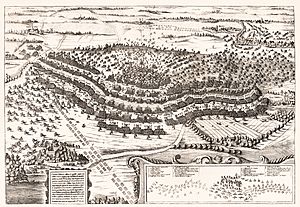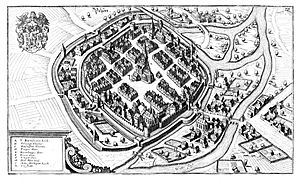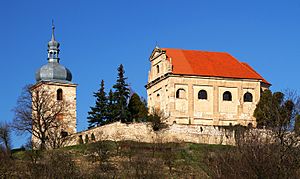Jan van der Croon facts for kids
Quick facts for kids
Jan van der Croon
|
|
|---|---|
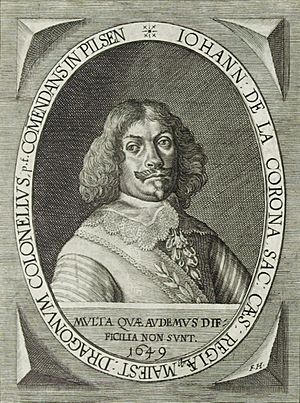 |
|
| Military commander of Plzeň | |
| In office 1645–1650 |
|
| Military commander of Prague, vice military commander of Bohemia | |
| In office 1652–1665 |
|
| Personal details | |
| Born | c. 1600 Weert |
| Died | 6 November 1665 Prague |
| Resting place | St. Thomas' Church, Prague |
| Military service | |
| Allegiance | |
| Service years | 1624–1665 |
| Rank | Lieutenant field marshal |
| Battles | Eighty Years' War Siege of Breda, 1624; Siege of Leuven; 1635; Siege of Schenkenschans, 1635 War of the Mantuan Succession Sack of Mantua, 1630 Thirty Years' War Rain, 1632; Alte Veste, 1632; Lützen, 1632; Siege of Regensburg, 1634; Nördlingen, 1634; Recapture of Lubin, 1640; Siege of Hirschberg, 1640; Siege of Görlitz, 1641; Battle of Schweidnitz, 1642; Raid on Litovel, 1642; Breitenfeld, 1642; Blockade of Głogów, 1644; Capture of Kiel, 1644; Blockade of Eger, 1647 |
Jan van der Croon (around 1600 – November 6, 1665) was a Dutch soldier who became a very important military leader. He served both the Spanish and the Holy Roman Empire. He started as a regular soldier and worked his way up to become a high-ranking general called a lieutenant field marshal.
During the Thirty Years' War, he became a commander of regiments and cities. After the war ended, he continued his military career in Bohemia. For many years, he was the commander of Prague and a top military leader in Bohemia. He helped make city defenses stronger and found new soldiers for wars.
Jan van der Croon also became a rich landowner and supported the Catholic church in Bohemia. He was special because he became a general even though he wasn't born into a noble family. This was very rare at that time.
Contents
Jan van der Croon's Life Story
From Soldier to Commander
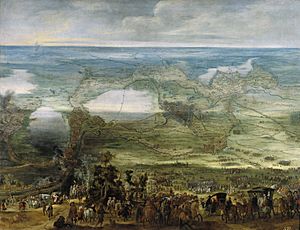
Jan van der Croon was born in a town called Weert in what was then the Spanish Netherlands. His family was known as Cool or Coolen. They were also called Croon because of an inn they owned named De Croon.
Jan started his military journey in 1624. He joined the Spanish army to fight in the Eighty Years' War. He looked up to his uncle, Giel Jonghen d'Ongarie, who was also a soldier. Jan was often called de la Corona by other soldiers.
He helped in the siege of Breda from August 1624 until the city gave up in June 1625. Soon after, he joined the Imperial army. He fought under Albrecht von Wallenstein in campaigns in Hungary and Holstein.
In 1629, Croon went to northern Italy with the Imperial army. They helped Spain in the War of the Mantuan Succession. In July 1630, he helped attack and capture Mantua. His leaders noticed his bravery, and he was promoted to corporal. Sadly, his uncle Giel died near Mantua.
After returning from Italy in 1631, Croon joined the Imperial and League army. In April 1632, he fought in the Battle of Rain against the Swedes. The Catholic League army lost this battle, and their commander, Count Tilly, was badly hurt.
Croon then fought under Wallenstein at the Alte Veste. After this battle, he was promoted to lieutenant. He also fought at the Battle of Lützen, where the Swedish king Gustavus Adolphus died.
After Wallenstein's death in 1634, Croon served under Aldringen. During the siege of Regensburg, he was wounded and captured by the enemy. But he managed to escape on his own!
In September, Croon fought in the Battle of Nördlingen. The Swedes were badly defeated there. After this victory, he was promoted to captain in a dragoon regiment.
With his new commander, Ottavio Piccolomini, Croon went to the Southern Netherlands. In July 1635, he helped successfully defend Leuven and capture Schenkenschanz. He was promoted again for his actions.
His regiment spent the next year in Bohemia or Saxony. After his commander died, Croon temporarily led the regiment. He led several successful raids against the Swedes, capturing horses and officers.
In 1637, Croon chased the Swedes with the main Imperial army. He was promoted to lieutenant colonel for his achievements. He spent 1638 fighting the Swedes in Mecklenburg. Later, his troops were sent to Silesia, where he continued to defend the area from Swedish attacks.
Becoming a Regiment Owner and City Commander
In 1640, Croon showed great skill in taking back the castle and town of Lubin. Because of this, Emperor Ferdinand III made him a colonel and commander of a dragoon regiment. This was a big deal because Croon was not from a noble family. From then on, he earned money directly from his regiment's actions.
With his regiment, he helped in the siege of Hirschberg in September 1640. He also helped recapture Görlitz in the summer of 1641. In May 1642, he tried to help the besieged fortress of Schweidnitz, but it failed. Croon escaped capture and led successful attacks against the Swedes in Moravia. He even raided the Swedish base in Litovel.
After the Imperial army pushed the Swedes out of Moravia and Silesia, Croon and his dragoons fought at the Battle of Breitenfeld in November. The Imperial forces were defeated there.
In May 1643, Croon was ordered to guard against the Swedes invading northern Bohemia. The Swedish army managed to cross the Elbe River, but they didn't attack Prague. Instead, they moved towards Moravia. When the Swedish army left for Denmark, Croon's regiment was sent to blockade the Swedish-held fortress of Głogów in Silesia. In March 1644, he captured Herrnstadt Castle near Głogów.
In June 1644, Croon and his regiment went to Holstein to help the Danes. In August, he helped attack and capture Kiel from the Swedes. Soon after, the Swedes moved south, threatening Saxony and Bohemia. Croon was wounded in the arm during a retreat.
Because of his injury and the tough campaign, he asked for a new role. In January 1645, Croon was stationed as the city commander in Plzeň, Bohemia. This meant he could leave active fighting. Plzeň successfully defended against the Swedes, and Croon stayed there for years, greatly improving the city's defenses.
In August 1647, Croon's regiment helped the Imperial army gather information before a cavalry fight at Triebl. His troops helped the Imperial forces know exactly what the Swedes were doing. This allowed them to defeat the Swedes at Triebl. Croon also made extra gunpowder for the army in Plzeň.
In October 1647, Croon recaptured a fort outside Eger from the Swedes. He then tried to blockade Eger, which the Swedes had captured, to starve them out. But he couldn't completely cut off the town before winter. Eger was close to falling when the Swedes sent a large cavalry force to help it. They broke through Croon's blockade and brought supplies to the starving town in April 1648.
Even though Croon had strengthened other towns, the Swedes conquered Falkenau in June 1648. However, they found Elbogen too strong and left. On July 22, the Swedes surprisingly appeared in front of Plzeň. They didn't attack the city but rode on to Prague, which they attacked by surprise on July 26. They captured the Lesser Town of Prague.
The Peace of Westphalia in October ended the fighting in Bohemia. After the war, most dragoon regiments were disbanded, but Croon's was kept.
General and Bohemian Military Commander
After the Thirty Years' War, Jan van der Croon stayed in the Imperial army. He helped with troop withdrawals from Swedish-occupied towns. In November 1650, he was made a baron and became part of the Bohemian nobility. He was now called Johann Freiherr von der Cron.
In 1651, he bought land in Bohemia, including the village of Zahořany. The next year, he was appointed commander of Prague and vice military commander of Bohemia. He was also promoted to Generalfeldwachtmeister, another high general rank. In 1653, he became the owner of the regiment that guarded Prague.
He worked very hard to improve the defenses of Eger and Prague. He also oversaw the maintenance of forts all over Bohemia. He even helped design the fortifications for Piccolomini's castle at Náchod.
When the Imperial forces joined the Second Northern War in 1657, Croon was in charge of finding new soldiers in Bohemia. He was considered so important that the court refused to let him command in Kraków because he was "indispensable" in Bohemia. In the war against the Turks in 1663–1664, he managed the movement of German troops into Hungary.
In the last year of his life, he was promoted to field marshal lieutenant, his highest rank. Jan van der Croon died in Prague on November 6, 1665. He was buried in St. Thomas' Church in Prague.
Properties and Legacy
In 1651, Croon bought many villages and lands around Zahořany. In 1663, he also bought Divice. In Prague, he owned two houses in the Lesser Town. One was where today's Liechtenstein Palace stands. The other was on Malostranské náměstí, which was later rebuilt into the Palais Kaiserstein.
With his wealth, Croon paid for the building of the Holy Trinity Church in Zahořany, which was finished in 1657. He also helped decorate a chapel at the Svatá Hora monastery. In 1662, he donated a beautiful enclosure for the baptismal font in the Saint Martin church in his hometown. It still has his family's coat of arms on it today.
Family Life
Jan van der Croon was married twice, but he did not have any children of his own. In 1662, he adopted his younger brother Franz as his heir. However, Franz died just a few weeks after Jan. So, the inheritance went to Franz's only daughter, Franziska Blandina van der Croon.


